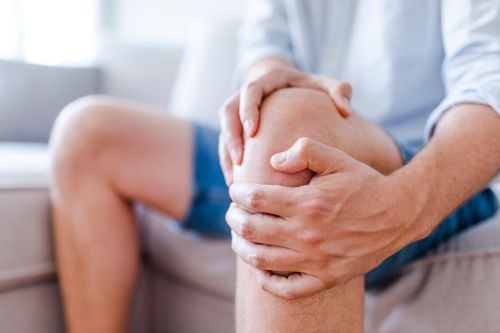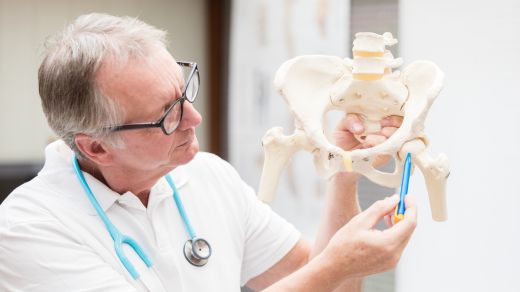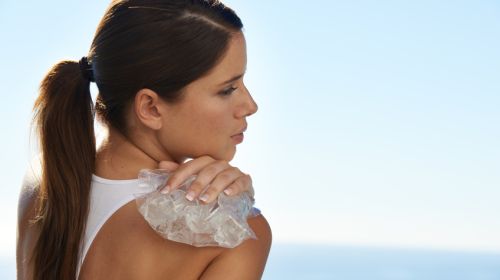Coxarthrosis is considered the most common form of arthrosis. This is a wear and tear of the cartilage and joints of the hip. The non-inflammatory disease progresses slowly and is often accompanied by severe pain that is initially stress-related. When is an artificial hip joint necessary?
- © Getty Images/Jan-Otto
Brief overview: coxarthrosis
What is coxarthrosis? Coxarthrosis is the technical term for wear and tear of the hip joint. This leads to a breakdown of the protective cartilage layer. If the protective cartilage recedes, the joint space in the hip becomes narrower. If the cartilage is completely broken down, the bony joint surfaces rub against each other.
Is coxarthrosis curable? Osteoarthritis of the hip cannot be cured, but it can be treated. The progression of the disease can be slowed down by various therapies. In addition, acute symptoms can be alleviated.
How common is coxarthrosis? Around five percent of adults in Germany suffer from osteoarthritis of the hip.
At a glance:
What is coxarthrosis?
Coxarthrosis (also hip arthrosis or hip joint arthrosis) is the medical term for a change in the hip joint due to wear and tear and aging (degeneration). Wear and tear of the joint first leads to degradation and finally to destruction of the articular cartilage in the hip. In later stages of the disease, other joint structures are also increasingly affected, including muscles, bones, ligaments and the sensitive synovial membrane. For example, in the course of cartilage loss, the bone is under stress, and its surface gradually changes. Typical of this are bony outgrowths, so-called osteophytes, on the joint surfaces. Later, the bone thickens and hardens. Experts also speak of subchondral sclerotherapy.
Coxarthrosis progresses insidiously and initially causes no or hardly any symptoms, later pain occurs when strain is applied. Even if hip joint wear is generally not an inflammatory disease, coxarthrosis can be accompanied by inflammatory flare-ups (activated arthrosis). This leads to phases of acute and persistent pain in the joint and other signs of inflammation.
Coxarthrosis: Most common form of arthrosis
Coxarthrosis is one of the most common forms of arthrosis alongside knee joint arthrosis. An estimated five percent of adults in Germany suffer from painful wear and tear of the hip joint, and the frequency increases with age. It mainly affects people over the age of 45, with women more frequently affected than men.
-

Osteoarthritis is wear and tear of the joints that is associated with pain. Are you at risk? Test yourself!
to the self-test
Osteoarthritis of the hip causes considerable costs in the healthcare system. In some cases, the greatly restricted mobility requires the insertion of an artificial hip joint. In 2020, around 294 “artificial hips” were implanted per 100,000 inhabitants in Germany. With the right measures, however, an operation can be avoided for a long time.
Coxarthrosis: Symptoms begin insidiously
The symptoms of hip arthrosis are very characteristic. However, they only occur when the cartilage damage progresses and the joint space narrows. The main signs of illness are:
hip pain: In around 95 percent of those affected, the pain first occurs at the beginning of a movement as start-up pain. A feeling of stiffness can also occur after prolonged rest and in the morning. The start-up pain initially subsides after a short time and only occurs again after prolonged exertion as fatigue pain. In the later course, the pain finally also persists at rest. In osteoarthritis of the hip, getting up from a deep chair is typically very painful; the hip pain often spreads from the groin to the thigh and sometimes to the knee.
Movement restrictions and muscle tension: Movement restrictions are initially caused by pain when patients adopt a relieving posture to avoid painful movements. This causes reflexive, i.e. involuntary muscle tension, which leads to further pain. Muscle tension that lasts longer (more than two weeks) ends in shortening (contractures) of the muscles and further restricts the possible range of motion.
friction noise: Abrasion of cartilage particles and the roughened cartilage surface often lead to another symptom in the case of advanced arthrosis: Rubbing noises can be heard above the joint or felt as a crunch when the joint is touched.
In the case of activated arthrosis, there are also signs of inflammation such as swelling, redness and overheating.
Causes and risk factors of coxarthrosis
The exact causes for the development of coxarthrosis have not yet been conclusively clarified. However, there are a number of risk factors that favor the occurrence of joint disease. Among other things, a hereditary predisposition comes into question.
Other possible causes of coxarthrosis:
congenital deformities of the hip joint (hip dysplasia)
misalignments of the legs (e.g. bow legs or knock knees)
misloads
joint injuries (e.g. broken bones, especially in the area of the femoral neck)
disorders in joint metabolism and inflammation (non-bacterial inflammation, rheumatoid arthritis, bacterial inflammation)
hip impingement (Excesses on the joint bones lead to bottlenecks and reduced mobility)
overweight
competitive sport (e.g. football and handball)
Hard physical work
In addition, diseases in childhood such as the juvenile femoral head dislocation or Perthes disease can trigger coxarthrosis. In Perthes disease, the femoral head is not supplied with sufficient blood, dies and deforms.
Diagnosis: how is coxarthrosis diagnosed?
As a rule, the symptoms of coxarthrosis are quite characteristic and clearly indicate the disease of the hip joint. The diagnosis is confirmed after taking the medical history and a physical examination, usually using an X-ray.
In addition, doctors have a variety of other equipment options available to reliably diagnose coxarthrosis, including computed tomography (CT) or magnetic resonance imaging (MRI). Both methods are used, for example, to rule out other diseases as the cause of the symptoms. Blood tests may also be necessary for this.
Treatment of coxarthrosis: when is a hip prosthesis useful?
Coxarthrosis cannot be cured, but is easily treatable. The treatment options depend on the symptoms and the current stage of the disease. The goals of treatment are to relieve pain and maintain mobility.
Treat coxarthrosis without surgery
Before an operation and a joint replacement are considered, the coxarthrosis is treated with conservative treatment methods.
The main focus here is a change in lifestyle in order to minimize possible risk factors that promote the progression of joint wear. Those affected with increased body weight should, for example, work on reducing excess weight in order to relieve the hip joint. In addition, exercise therapy and joint-gentle rehabilitation sports can help to relieve the hips and build up muscles in the thighs. However, caution is advised in the case of an activated coxarthrosis: During an inflammation, the joint should be protected as much as possible.
Wearing flat and comfortable shoes is also recommended. Additional relief is possible with soft shoe soles (buffer heels). They prevent the shock from being transmitted to the hip joint when you step on it.
Other treatment options are:
- heat/cold therapy
- anti-inflammatory painkillers (such as NSAIDs)
- Cortisone injections (not suitable for long-term use)
There are also many over-the-counter herbal medicines and dietary supplements, for example with extracts from avocado, soy and devil’s claw or active ingredients such as glucosamine and chondroitin. However, the effectiveness of these preparations has not been proven in studies. In case of doubt, coxarthrosis should therefore not be treated with appropriate means.
Hip arthrosis surgery
If the everyday life of those affected is made very difficult by the wear and tear of the hip joint and other therapy attempts are ineffective for more than three months, surgery is usually the method of choice. As a rule, the hip joint cannot be preserved, and the use of a hip prosthesis (artificial hip joint) is necessary. Both the joint head and the hip socket are often replaced, and experts also speak of a total hip endoprosthesis (hip TEP).
Only a doctor can decide whether, when and for whom an operation and a new hip joint are suitable. The operation to insert total endoprosthesis promises long-term help, but is also associated with risks. Possible complications are:
- thrombosis
- Wound healing disorders
- bleeding
- infections
- nerve damage
- problems during anesthesia
After hip surgery and the use of the prosthesis, rehabilitation is very important. Those affected should use physiotherapy to train the mobility of the hip joint and build up muscles in a targeted manner.
How can osteoarthritis of the hip be prevented?
Osteoarthritis of the hip can be prevented quite well. In the case of major misalignments, for example congenital hip dysplasia that is only discovered late, preventive measures maintain the quality of life for a long time and help to delay an operation. This is also an advantage because no artificial hip joint lasts forever, even if the advances in this field are great today.
The possible measures for the prevention of coxarthrosis include:
Avoidance of incorrect loads: for example through sports, shoe inserts
Avoiding an overload: Reduction of overweight, avoidance of incorrect loads
Regular exercise: Joint-gentle sports such as cycling or swimming
Varied diet: Nutrients for healthy cartilage
Appropriate treatment of injuries to the joint: such as by resting
Elimination of possible misalignments: for example through orthoses (shoe inserts), operations


